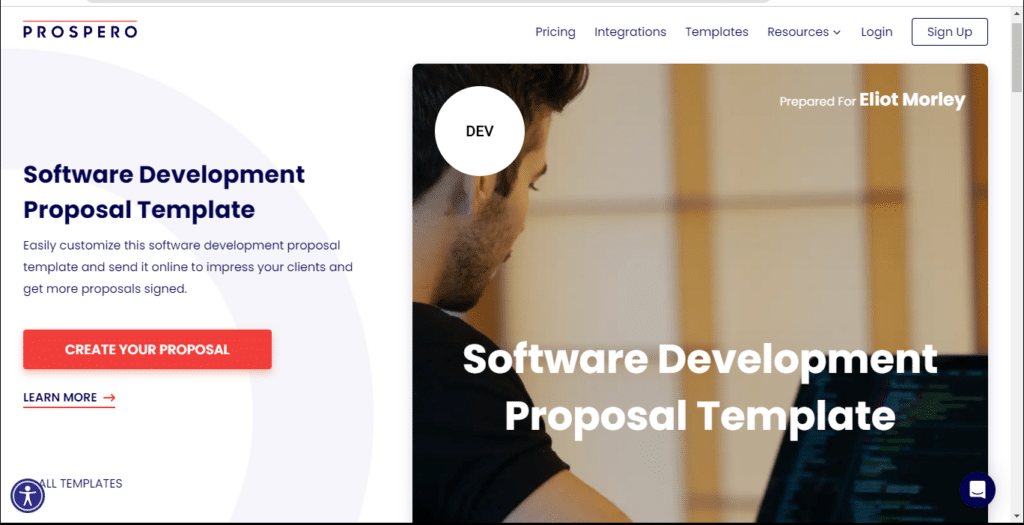Even as a top software development professional, winning contracts is not necessarily the easiest thing in the world. Having the talent to bring a solution to life does not necessarily translate to immediate confidence in your abilities, resources, etc.
This is why a software development proposal is essential and why it needs to be done well. A well-crafted software development proposal not only showcases your expertise and understanding of the client’s needs but also persuades them that you are the best fit for their project.
With that said, why are we here today? Well, the intention is to walk you through the essential elements of a winning software development proposal and provide you with the information you need to put your best foot forward on your next software development proposal.

Identifying the Project or Problem
One of the key things you need to do well is identify the problem or the project opportunity in front of you. If you know of the software crisis decades ago, you probably also know that improper requirement definitions accounted for most of the challenges.
This is still an issue today. Requirement elicitation can be difficult as what is communicated does not necessarily match the intent.
It goes without saying then that being able to identify and confirm the problem well is one of the first steps to demonstrating that you have a grasp of what is happening.
Understanding Customer Needs
Effectively, what you’re trying to achieve is to get your potential customers to the point where they believe that not only do you understand their needs well, but that you also have the tools and capabilities to take care of the said needs. In other words, your delivery needs to show that the customer is prioritized.
Proposed Solution
Of course, the proposed solution is essential. After all, this is going to be what you have to show for the undertaking. Provided that you’ve done a good job in understanding the problem and representing yourself well in communicating that, now it’s time to get the buy-in that you need into your proposed solution.
Bear in mind though that you will likely be putting this forward to business decision-makers. Therefore, balancing the technical language with the kind of insights that strategic thinkers like to see is a skill that must be well developed.
Perhaps you want to consider the assistance of a well curated software development proposal template.

Project Timeline and Milestones
On the note of business decision-makers and how they think, SMART objectives tend to be a central focus. In other words, objectives must be specific, measurable, achievable, realistic, and time-based.
As you can see, all these adjectives introduce a level of precision into the equation. If you can represent how you intend to carry out your solution in milestone and timeline terms, you are much more likely to see a favorable outcome.
Proposal Length
The rule of thumb here is to prepare both long and short business proposals and to even try to find a middle ground if you have no information to go off.
However, what you will sometimes find is that organizations will sometimes request the length they’re looking for. Some may request shorter proposals, especially for initial inquiries where they’re just trying to understand what the cost implications will look like.
Other potential clients may ask for longer proposals detailing the different aspects of the project.
Of course, if you get a specific request, considering you’re trying to win the client, you need to ensure that your proposal aligns with it.
Step-by-step Guide for Writing a Software Development Proposal
1. Executive Summary
Your executive summary will tell the client who you are. Ensure that it’s concise and includes the essential details. These will include the project name, your contact information, the project scope, what benefits the customer can expect, any restrictions, and your core strengths where software development is concerned.
2. Project Identification
You want to hit the proverbial nail on the head as early as possible. This is how you will truly demonstrate that you understand what it is that the potential client is looking for. You can do this by incorporating information that the customer may have provided in conjunction with whatever research you did.
3. Description of Needs
This is an offshoot of the previous point. In ensuring that you understand what the client is looking for, compile a requirement list for the solution that you see fit to address the immediate needs.
This will allow feedback to be provided and it’s also a demonstration that you have a vested interest in solving the problem and not only in your payday.
4. Deliverables
What will the deliverables look like? This is where you start to talk about the phases and milestones. It cannot be emphasized enough how clear you need to be at this stage of things, as the last thing you want later on is scope creep. Going this route and clearly outlining the different phases and what is to be expected will eliminate any doubts going into a contract.
5. Why It Works
You have competitors out there, so why should prospective clients use your services instead of theirs? More importantly, if the internal bandwidth exists, why should you be paid for a solution as opposed to the client just handling it themselves?
This is where differentiation is incredibly important. Now it’s not just about how you can fulfill the needs of the customer. It’s time to show your area of differentiation. This could be your language, the programming paradigm used, etcetera. Perhaps a list of itemized pros and cons will help.
6. Timelines
Get specific with the timelines since you will have clearly laid out the different milestones that will form a part of the project. Remember the SMART objective reference used above. These people need to know how long each step is going to take.
Apart from giving insights on what they should expect, this is also a demonstration that you took the time to do your due diligence on the project and understand the different elements that would be needed. How else would you be able to articulate phase and task length?
7. Cost Estimate
The more previous projects you have, the easier this is. Give an estimate of what you think will likely be the charge for the kind of project being undertaken. Additionally, ensure the clients understand how they will be charged, whether it is by milestone, hourly, etc. Obviously, this is an essential section, so get detailed.

8. Potential Concerns
Is there anything you foresee potentially affecting the project? This is the time to talk about it, even if you think the concern is not a big deal. It’s easier to ask for more time or money for something you had previously identified when the time comes.
9. Testimonials
Your reputation is important, and using your successes to your advantage in your proposal is recommended. Do you have experience with similar projects? Include industry references, case studies, etc. On that note, whenever you do win a contract, it’s good to encourage testimonials.
Conclusion
Obviously, the importance of a good software development proposal cannot be overstated. The main takeaway is that you need to convey the extent to which you understand the problem, your vested interest in solving it, how you are going to go about it, and any other important expectations.
While ah this can seem like a lot to consider, you thankfully don’t have to do it alone. While you should follow the proposal writing guide for the best results, don’t ignore the extent to which proposal writing software can make a huge difference. Try Prospero today and take advantage of various templates and integrations that can make your next proposal incredible!
Frequently Asked Questions
What are some common proposal writing mistakes?
Common proposal mistakes include not discussing the scope or problem at all or enough, inaccurately calculating financial elements, not speaking enough about how you will solve the problem, and not making it easy for clients to reach you.
Should a cover letter be included?
While it’s not mandatory, a cover letter with an introduction goes a long way. The trick is to be personal without being too casual.
What can I do to make my proposal more readable?
Whether your proposal is long or short, consider summarizing the details in a table, which will make it easy to reference.




